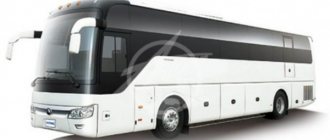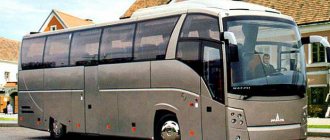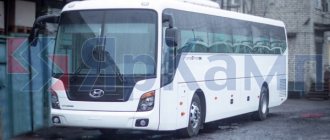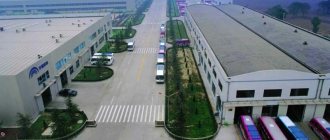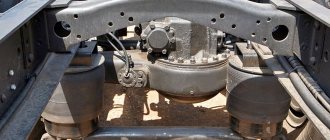Sweeping away standards
Andrey Filippov, photo by the author
| Manufacturer: | Minsk Automobile Plant (Republic of Belarus) |
| Model: | MAZ-205069 |
How many copies were broken in heated debates on forums and in personal meetings among fans of public transport regarding the placement of the engine compartment in the head part of the MAZ-105 cannot be expressed in words. And now the new “articulated” vehicle of Minsk car No. 11, 2009) has the same layout. The short October presentation did not allow us to properly evaluate all the “pros” and “cons” of the MAZ-205, and we decided to correct this omission. In addition, over the past six months, they released a second copy of the bus, closer to the realities of our open spaces.
What is unique about the new product?
MAZ-203945 is not the first gas model of passenger vehicles of MAZ OJSC. Let us remind you: in 2013, when a government-supported campaign for the gasification of vehicles was launched in Russia, and in Belarus the issue of using gas as a motor fuel began to be discussed at the state level, the MAZ-203965 bus with a Mercedes-Benz gas engine of Euro-5 level was presented . In 2014, serial production of this machine began.
MAZ-203965. Photo of OJSC "MAZ"
In 2015, two more models with Mercedes-Benz gas engines were released - the “budget” semi-low-floor MAZ-103965 (Euro-5) and the MAZ-203988 (Euro-6) aimed at the European market. In addition, based on the basic models, various modifications were developed, differing in body length and gearboxes, including commuter ones.
MAZ-103965. Photo of OJSC "MAZ"
MAZ-203988. Photo of OJSC "MAZ"
All three models are designed to operate on compressed natural gas and are equipped with polymer-composite gas cylinders, which are placed on the roof. In 2015-2019 MAZ manufactured and sold almost two hundred such vehicles to Russia, Ukraine and Belarus.
The largest one-time delivery took place in 2015 to Yekaterinburg - the city received 59 MAZ-203L65 buses (a modification with a length increased by 50 mm due to the rear bumper).
The MAZ-203945 delivered to Chelyabinsk is the first model in the line of passenger vehicles of the Minsk Automobile Plant that runs on liquefied natural gas (methane). Instead of cylinders on the roof, the bus is equipped with a cryotank, which is located in the rear overhang.
The geometric volume of the cryotank is 350 l, the effective volume is 300 l. It holds 120-130 kg of liquefied gas. This amount of fuel provides a range of about 400 km when driving in the urban cycle. At the same time, 400 km is an indicator that completely satisfied the customer.
Another difference between the MAZ-203945 and its counterparts running on compressed gas is the engine. If the MAZ-203965 and MAZ-103965 use the German gas Mercedes-Benz M 906 LAG EEV/1-02 (P6, 6883 cc; 278 hp; 1000 Nm; Euro-5), then the MAZ-203945 — Chinese gas Weichai WP7NG 280E51 (in the future, MAZ-Weichai of the same model will be installed). This engine is also an in-line 6-cylinder, with turbocharging and charge air cooling, with distributed gas injection and spark ignition. It has a displacement of 7470 cc, a power of 270 hp, a maximum torque of 1100 Nm and complies with the Euro 5 environmental standard.
Bus in itself
The new Mazovskaya “accordion” is a unique product. In Europe, it faces a battle on two fronts: firstly, of course, it will have to prove that the product from Belarus can meet the high demands of Europeans in quality, and secondly, the non-standard layout will also require confirmation of its viability. The MAZ-205069 has a straightforward design and a relatively low initial price with a large selection of possible optional equipment and various components.
But in the post-Soviet space, the same price is already relatively high, and stylish design delights are perceived as unnecessary, and also requiring unreasonable costs in case of repairs. And some layout solutions seem to be the momentary whim of a particular customer. Moreover, even satisfying these requests does not mean buying a car, and the fact that both copies are still not in trial operation in Germany or Moscow, as the Belarusians assumed, but are still at the factory, is further confirmation of this. But the reliability and maintainability of MAZ buses is already known to the operators. And from a passenger’s point of view, the bus is quite attractive. So let's hope that this truly modern bus will find its buyer, and passengers will appreciate it themselves, and not from the words of the writing fraternity.
The vehicle was provided for testing.
Technical characteristics of the MAZ-205069 bus (according to the manufacturer)
| Total weight, kg | 28 000 |
| Curb weight, kg | 16 100 |
| Wheel formula | 6x2 |
| Passenger capacity, person: nominal/maximum/incl. seated | 175/ 185/ 39 |
| Permissible load on the 1st/2nd/3rd axle, kg | 6900/ 11 500/ 10 000 |
Engine:
| MB OM 906LA (EEV/3), turbodiesel, I-6, Euro5 7201 326 at 2300 min-1 1300 at 1200–1500 min-1 |
Transmission:
| Automatic Voith D854 4/ 1 |
| Suspension | Pneumatic, with kniling function |
| Brake system | Pneumatic, dual-circuit |
| Minimum turning radius, m | 12,5 |
| Fuel tank capacity, l | 220 |
“If you want to win the tender, you need to install Chinese engines”
Why Weichai and not the well-established Mercedes-Benz? “This was a conscious choice,” Yuri Syrokvash, chief designer of the service of the chief designer of buses at MAZ OJSC, . — Yes, we used to work with Mercedes. But they are now discontinuing their Euro 5 gas engines and will only produce Euro 6. And this is a rather complex and expensive unit. At the same time, the Chinese are now, objectively speaking, so to speak, the leaders in gas engine technology. At the same time, their motors are cheaper. Therefore, if you want to win the tender, you need to install Chinese engines and Chinese cryogenic tanks.”
NEFAZ-5299-40-52. Photo of KAMAZ PJSC
Volgabus "Cityrhythm" 12 GLF. Photo of the holding company "Bakulin Motors Group"
It is worth noting that the largest Russian manufacturers of passenger vehicles - KAMAZ PJSC (NEFAZ is its subsidiary) and the Bakulin Motors Group holding (Volgabus brand) - also began to install Chinese engines. For example, the restyled NEFAZ-5299-40-52 are equipped with Weichai WP7NG 260E51 motors, and the Volgabus “Cityrhythm” 12 GLE / GLF are equipped with Yuchai YC6L280N-52 motors. And only LIAZ continues to use exclusively Russian-made engines (YaMZ-53624 CNG).
As for the gearbox, at the customer’s request, Chelyabinsk buses are equipped with an automatic American Allison T310w/Ret. The rear axle is a portal axle with double transmission ZF AV 133/80.
The use of the Weichai WP7NG 280E51 gas engine and the technology of storing liquefied gas fuel in a cryotank on the MAZ-203945 necessitated the redesign of not only the engine compartment, but also the interior in the rear. As a result, we had to sacrifice four seats at once (compared to, for example, the MAZ-203965).
However, the total number of seats remains quite large: 26 or 28 depending on the layout. The maximum total passenger capacity is 98 people (95 if air conditioning is installed).
OTTS was also received for the suburban modification of the MAZ-203C45, which has only two doorways. Such a bus can have 30 or 32 seats - this depends on the layout of the storage area with an equipped space for one wheelchair. The maximum total passenger capacity is the same - 98 people (95 when installing air conditioning).
With a key and a rag
As it turned out, design decisions do not always harm the everyday use of technology. No, I’m not talking about the windshield, which, while beautiful in appearance, is just as vulnerable and expensive to replace; it would probably be worth separating the route indicator. I'm talking about the engine compartment lid that was changed on the second copy.
The lid, painted black, now merges with the tinted window sill line, and does not glow in it, albeit brightly, but still like a blot. And the operators, I think, positively appreciated that the scattering of miniature poorly located hatches was replaced with one in the entire wall and a couple of additional ones in the side of the roof. In general, only the fuel tank remained on the right, but the left side of the tractor collected all the components that were possible. There are pneumatic outlets and a battery, a fuel filter and a urea tank, of course, and there is access to the engine - you just have to squat down and you can do repairs. I liked that all this equipment is covered from below with a metal protection, which means that the engine compartment will not turn into a mud bath. By the way, excellent access to the engine remains from the passenger compartment; after all, the shaft location of the engine has its undeniable “advantages”. However…
The expansion tank, as in the MAZ-103, MAZ-203 remained somewhere in height. It is clear that the high-mounted radiator required placing the expander under the roof itself, but what should the driver do? No one argues that on a new car the radiator honeycombs will clog less, providing better cooling, and the “fresh” rubber of the pipes will ensure the tightness of the system. But what will happen in a year, when the pipes begin to leak due to temperature changes? The driver is not an acrobat, but the need to add antifreeze to the system usually arises at the most inopportune moment, for example, on a turning circle, where you can’t even buy a stepladder for money.
But what a toolbox the 205 has! Opening the aft compartment lid, you can find a serious towing eye behind it, but the driver will undoubtedly not be pleased with it. Even offhand, the “trunk” will fit at least four 20-liter cans for honestly saved fuel or spare parts for half the bus - I take everything with me.
And since I mentioned this “glove compartment,” I’ll tell you about the reverse alarm located in it. I don’t know what kind of “bright” mind thought of using for this purpose not the usual “squeaker”, but a full-fledged sound signal. But the fact that when the bus moves back will not have very flattering comments about it, that’s for sure. Even in the driver’s seat, this ringing hurts the ears, but I was afraid to even check what it was like outside. Maybe you shouldn't save SO much?
“We decided to be proactive”
The use of liquefied methane as a motor fuel in vehicles is a very promising direction. Vehicles running on liquefied natural gas have two advantages over compressed natural gas: lower curb weight, and therefore less loss in payload/passenger capacity, and a larger range.
The only thing currently holding back the development of LNG transport is the underdevelopment of infrastructure: there is simply nowhere to refuel such equipment. But the situation is changing: in Russia, the Gazprom and Novatek concerns have begun creating a network of cryogenic automobile filling stations (Cryogas stations) both in individual regions (pilot projects) and along main highways (including the “gasification” of the M1 Moscow highway - border with the Republic of Belarus). And, according to experts, by 2030, long-distance transport will consume up to a third of the total volume of LNG produced in Russia.
The Minsk Automobile Plant is already working on the creation of long-haul LNG-powered vehicles. Last year, the MAZ-54A02K tractor was presented with a Weichai Power WP12NG 400E50 gas engine and two cryotanks with a total volume of 688 liters. Power reserve - more than 700 km
LNG distribution is planned in Russia and in passenger transport. In particular, in Chelyabinsk, as part of the implementation of the Clean Air program, it was decided to purchase city buses using both compressed natural gas and liquefied gas. And the Minsk Automobile Plant took part in this project.
“Together with Russian partners, we began to explore the possibility of supplying buses powered by liquefied methane in the fall of 2022,” said Vladimir Dormash, Deputy Commercial Director for Sales of Passenger Equipment - Head of the Passenger Equipment Sales Department of MAZ OJSC . — Of course, we could sit and wait until the Russian regions themselves come to the understanding that they need such transport, wait until the necessary infrastructure is created there. But we decided to be proactive: make LNG-powered transport and offer it along with the prospects for infrastructure development.”
MAZ moved toward its goal in stages. Strong support was provided by the Belarusian Foreign Ministry, our embassy in the Russian Federation and directly by Ambassador Vladimir Semashko, who took part in negotiations both at the level of the governor of the Chelyabinsk region and with the Ministry of Industry and Trade of the Russian Federation. In December 2022, an important meeting was held at which the Chelyabinsk region was promised that MAZ, at its own expense, would make samples of passenger vehicles powered by liquefied methane and provide them for operational testing. At the same time, the automobile plant signed a road map for this project with the Chelyabinsk region.
Already in April 2022, MAZ produced prototypes of 12-meter and 9-meter buses powered by LNG. The Minsk Automobile Plant became the first in the CIS countries to create such cars and receive official OTTS for them. In May, the buses arrived in Chelyabinsk for testing.
MAZ-206945 is generally the first middle-class gas bus in the line of the Minsk Automobile Plant. It is equipped with a 200 hp Weichai Power WP5NG 200E51 (Euro 5) engine and an Allison-T270w/Ret automatic transmission
For a month and a half, the vehicles were operated on various city routes in Chelyabinsk, carrying passengers. Local transport workers measured fuel consumption and assessed the compliance of the declared technical parameters. Based on the test results, it turned out that in comparison with similar equipment from Asian manufacturers, which was previously operated on a trial basis in Chelyabinsk, MAZ buses powered by LNG were approximately 40% more economical.
Due to the installation of a cryogenic tank, the layout of the interior in the rear part changed - the last row of seats had to be abandoned. The total passenger capacity of MAZ-206945 is 67 people. Seating – 22
Last summer, in accordance with the procedures of federal laws, tenders were announced for the supply of 33 large-class LNG buses and the same number of CNG buses to Chelyabinsk. In August, MAZ won a tender for the supply of equipment powered by liquefied methane, and the Russian LIAZ won a tender for the supply of buses powered by compressed natural gas. By the end of the year, all equipment entered the fleet of the municipal carrier LLC Public City Transport. In December, MAZ-203945 buses went on routes.
Photo of the official website of the Chelyabinsk City Administration
Photo of the public “Chelyabinsk Transport” on the social network VK.com
Thus, the Minsk Automobile Plant was the first in the CIS countries to organize mass production of passenger vehicles running on liquefied methane.
It is worth noting that neither LIAZ nor the Bakulin Motors Group holding company yet have similar vehicles at all. In September 2019, KAMAZ presented the LNG-powered NEFAZ-5299-40-57 model at the Comtrans exhibition in Moscow, but this is still an experimental vehicle that has yet to undergo testing and then the certification procedure.
By being proactive, the Minsk Automobile Plant gained an advantage: when Chelyabinsk announced a tender for the supply of buses powered by liquefied natural gas, competitors simply did not have the required equipment.
In 2022, the Chelyabinsk mayor's office expects to receive funding for the purchase of another 100-150 gas-powered buses. And here MAZ OJSC has a good chance of getting a new contract.
By the end of 2022, the 74th Russian region plans to purchase a total of more than 400 gas-powered buses for 4 billion Russian rubles. In addition to Chelyabinsk, they will be sent to other cities in the region, where they will open gas filling stations and provide the necessary infrastructure. But here the prospects for the Minsk Automobile Plant, unfortunately, are already vague: Russian manufacturers will certainly have time to create and certify their own LNG buses - it will be almost impossible to compete with them on equal terms.
The fact is that Russian municipal carriers receive government subsidies for the purchase of gas-powered passenger vehicles, provided that they are produced in the Russian Federation. Thus, for the same gas 12-meter LIAZ buses, which arrived in Chelyabinsk last fall, the subsidy amounted to 1 million 866 thousand Russian rubles per unit. And for 12-meter buses running on liquefied methane, the subsidy will be even greater - 2 million 800 thousand Russian rubles. And it does not apply to MAZs, emphasized Vladimir Dormash.
Design and dimensions of MAZ-103
The bus body is load-bearing and all-metal, and has a carriage type structure. Both the roof and sides of the bus are entirely made of solid metal sheets, while the front part is made of fiberglass. Together with glued glass, this creates optimal body rigidity with a high degree of safety for passengers.
The design type can also be called carriage style. The front part of the bus is represented by a small bumper, in the corners of which small “rounds” of fog lights are integrated, and above them, with a decrease in size, there are several more separate “rounds” of low and high beams and turn signal indicators. The windshield is split in two at the center with a large wiper blade for each side. At the very top of the MAZ-103 there is a large electronic route indicator board with replaceable route signs.
In profile, the bus has extended wheel arches, large side mirrors with a vertical orientation, there is also another route indicator board in the upper part, and the window sill line rises closer to the rear.
The rear part is mainly covered with a solid sheet of metal, there is a false radiator grille and rear optics similar to the front lights.
Dimensions correspond to the class and have the following values:
- Length is 11,985 mm;
- Width – 2,500 mm;
- The height is in the range – 3,120-3,400 mm;
- Distance between axles – 6,140 mm;
- Total weight – 18 tons.
The car is available in two versions. The first is intended for urban use, and the second for suburban use.
Looking to Europe
So, was it in vain that Minsk invested in the development of LNG buses? No, not in vain. Firstly, MAZ has already delivered 33 buses powered by liquefied methane to Russia. Secondly, the leadership of the Union State, the Belarusian Foreign Ministry and the Belarusian Embassy in the Russian Federation promise that certain steps to bring the two countries closer together on this issue will be taken in the near future. Thirdly, the opportunity arose to implement a project to organize joint production of Belarusian buses powered by liquefied gas in the Chelyabinsk region. Once a certain level of localization of this production is reached, MAZ buses assembled in Miass will be subject to the same preferences as LIAZ, NEFAZ, and Volgabus vehicles. Fourthly, subsidies do not last forever: Russian regions are increasingly willing to purchase gas-powered vehicles, since they have managed to convince themselves of their safety, efficiency and quick payback - state support may soon be simply cancelled.
In addition, demand for buses powered by liquefied methane is starting to grow in Europe. And the Minsk Automobile Plant, which received a trump card in the form of a third-generation bus, is now quite seriously considering this prospect.
As for Belarus, not everything is hopeless here either. has already put on the agenda the construction of the first small-scale liquefied natural gas production complex in Belarus. In the future, it is possible that the Novatek concern and other players who are interested in developing this area will enter the Belarusian market and will themselves offer cooperation. And as soon as the infrastructure appears, the Minsk Automobile Plant will be able to offer a wide range of equipment.
Heavy vehicles for tough work. Our ad database contains more than 7.5 thousand offers for trucks and buses
Advantages and disadvantages
Enterprises from the Republic of Belarus are constantly working to modernize the technological process and the quality of products in general. The focus of activities on improving the technical and operational characteristics , as well as the design of buses, allows companies to produce models that are in demand in many countries. A variety of vehicles, a modern, recognizable, attractive appearance, the use of reliable components and assemblies, a good level of comfort and safety are the main positive characteristics of buses produced in Belarus.
Bus Neman 52012. Photo Wikipedia
An important advantage for many clients is the reasonable cost , especially in comparison with European analogues. Ease of use, good maintainability, ease of purchasing spare parts, knowledge of specialists in the field of maintenance and repair of the features and weaknesses of the models are the components that ensure high demand for equipment.
In addition to a wide range of advantages, buses also have some disadvantages. In particular, owners, drivers and passengers note that the build quality is not very high, the level of noise and vibration in the cabin is high, and frequent minor breakdowns occur.
